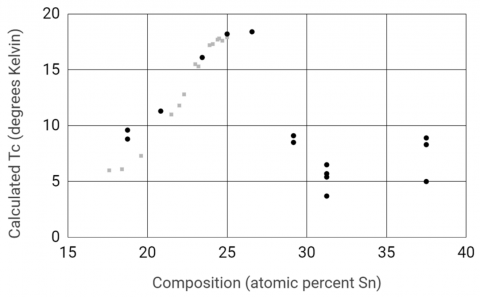Effect of the density of states at the Fermi level on defect free energies and superconductivity: A case study of Nb₃Sn
H. Devantay, J. L. Jorda, M. Decroux, J. Muller, and R. Flükiger, The physical and structural properties of superconducting A15-type Nb-Sn alloys, J. Mater. Sci. 16, 2145 (1981)
R. Flükiger, Superconductivity in d- and f-band Metals (Springer, Berlin, 1982)
A. Godeke, A review of the properties of Nb3Sn and their variation with A15 composition, morphology and strain state, Supercond. Sci. Technol. 19, R68 (2006)
This paper seeks to understand the behavior of defects in Nb3Sn superconducting radiofrequency (SRF) cavities, in particular "antisite" defects where a niobium atom occupies the usual position for tin in the Nb3Sn crystal and vice versa. We use the computational technique density functional theory (DFT) to calculate the effect of antisite defects on the electronic structure of Nb3Sn. From these computational results, we gain new understanding of how antisite defects form and migrate around during Nb3Sn growth, and new understanding about how high concentrations of antisite defects can adversely affect the superconductivity of Nb3Sn, and thus limit cavity performance. Based on these findings, we make recommendations to improve the Nb3Sn growth process to mitigate the adverse effects of antisite defects on cavity performance.
These results advance our goal of developing new Nb3Sn growth recipes for higher-performing Nb3Sn SRF cavities.
Nb3Sn offers many advantages over Nb as a material for SRF. Most importantly, its higher efficiency and higher operating temperature would make SRF facilities smaller and cheaper.
This work demonstrates the usefulness of DFT for calculating important material properties that are difficult to measure directly. A more complete understanding of material properties facilitates the development and optimization of advanced materials.
N. S. Sitaraman, M. M. Kelley, R. D. Porter, M. U. Liepe, T. A. Arias, J. Carlson, A. R. Pack, M. K. Transtrum, and R. Sundararaman,“Effect of the density of states at the Fermi level on defect free energies and superconductivity: A case study of Nb3Sn,” Phys. Rev. B, vol. 103, no. 11, p. 115106, Mar. 2021, doi: 10.1103/PhysRevB.103.115106.

